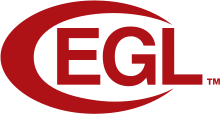 | |
| Original author(s) | Khronos Group |
|---|---|
| Developer(s) | Khronos Group |
| Stable release | 1.5[1]
/ March 19, 2014 |
| Written in | C |
| Operating system | Cross-platform |
| Platform | Cross-platform |
| Type | API |
| Website | www |
EGL is an interface between Khronos rendering APIs (such as OpenGL, OpenGL ES or OpenVG) and the underlying native platform windowing system. EGL handles graphics context management, surface/buffer binding, rendering synchronization, and enables "high-performance, accelerated, mixed-mode 2D and 3D rendering using other Khronos APIs."[2] EGL is managed by the non-profit technology consortium Khronos Group.
The acronym EGL is an initialism, which starting from EGL version 1.2 refers to Khronos Native Platform Graphics Interface.[3] Prior to version 1.2, the name of the EGL specification was OpenGL ES Native Platform Graphics Interface.[4] X.Org development documentation glossary defines EGL as "Embedded-System Graphics Library".[5]
YouTube Encyclopedic
-
1/1Views:1 428
-
Creating A Modern OpenGL Game Engine - Day 24
Transcription
Adoption
- The BlackBerry 10 and BlackBerry Tablet OS mobile device operating system uses EGL for 3D graphics rendering. Both support EGL version 1.4.[6]
- The Android mobile device operating system uses EGL for 3D graphics rendering.[7]
- The Wayland display server protocol uses EGL.[8] It is implemented in a way that Wayland clients will draw directly to the framebuffer using EGL.
- Mesa 3D has an implementation of EGL formerly known as Eagle.[9]
- The Mir display server protocol by Canonical Ltd. uses EGL.[10]
- The Simple DirectMedia Layer toolkit has been ported to use EGL. It can use Xlib, write directly to the framebuffer or use EGL.
- The Raspberry Pi single-board computer has an EGL interface to hardware-accelerated 3D graphics rendering.[11]
- The proprietary Nvidia driver 331.13 BETA from 4 October 2013 supports the EGL API.[12]
- Tizen OS uses EGL with either OpenGL ES 1.1 or OpenGL ES 2.0 for 3D graphics rendering[13]
Implementations
- Mesa is a free and open-source software implementation of many graphic rendering APIs; among them is EGL.
- Generic Buffer Management is an API to manage buffers.
See also
- WGL – the equivalent Windows interface to OpenGL
- CGL – the equivalent OS X interface to OpenGL
- GLX – the equivalent X11 interface to OpenGL
- AIGLX – an attempt to accelerate GLX
- WSI – the Vulkan Window System Interface (WSI) does for Vulkan what EGL does for OpenGL ES.
References
- ^ "Khronos releases EGL 1.5 specification". Khronos Group. 2014-03-19. Retrieved 2014-03-20.
- ^ EGL Overview
- ^ EGL 1.2 Specification
- ^ EGL 1.0 Specification
- ^ EGL in X.Org development documentation glossary
- ^ "Developer Guide". Archived from the original on 2013-10-10. Retrieved 2014-05-28.
- ^ "Gingerbread".
- ^ "Pekka Paalanen: What does EGL do in the Wayland stack". 10 March 2012.
- ^ Mesa EGL
- ^ "MirSpec". Archived from the original on 2013-03-06. Retrieved 2013-03-07.
- ^ http://elinux.org/RPi_VideoCore_APIs
- ^ "Added support for the EGL API on 32-bit platforms. Currently, the supported client APIs are OpenGL ES 1.1, 2.0 and 3.0, and the only supported window system backend is X11". 2013-10-04. Retrieved 2013-10-05.
- ^ "Porting Guide/Graphics and UI - Tizen Wiki".


